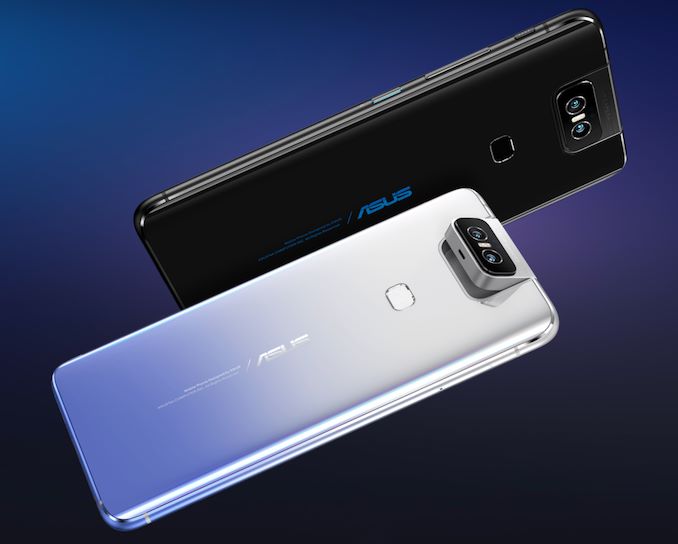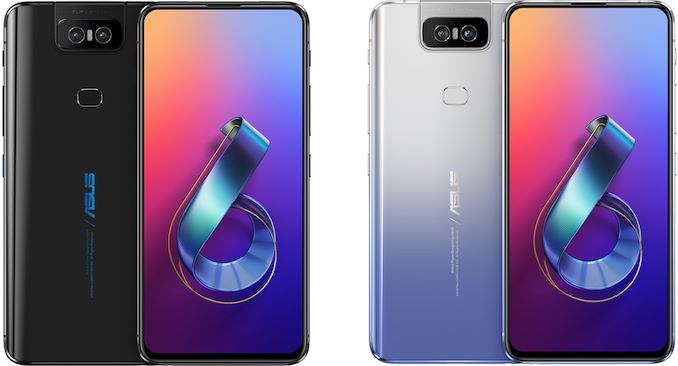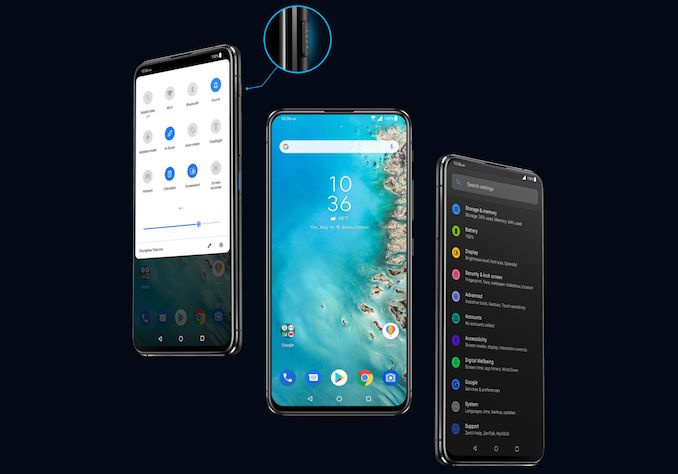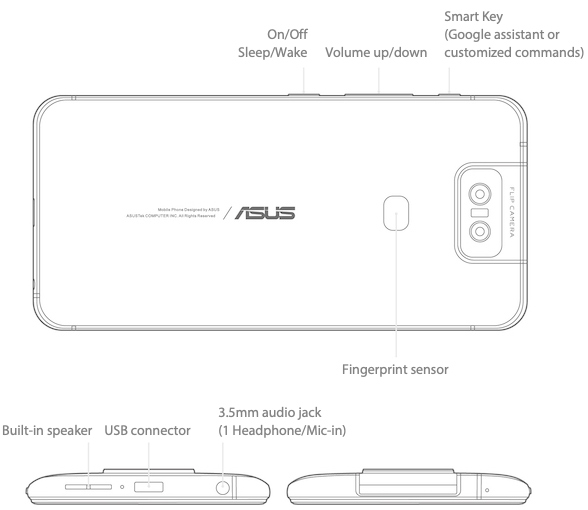ASUS Launches the ZenFone 6: 6.4-Inch Flagship Phone With Motorized Flip-Up Module Camera
by Anton Shilov on May 21, 2019 9:00 AM EST- Posted in
- Smartphones
- Asus
- Mobile
- Zenfone
- Snapdragon 855
- ZenFone 6

ASUS has introduced its new high-end smartphone, the ZenFone 6. The new handset is based on Qualcomm’s top-of-the-range Snapdragon 855 SoC, and perhaps most interesting of all, a motorized 180° flip-up camera module.
Featuring a huge NanoEdge 6.4-inch display with a 92% screen-to-body ratio, the ASUS ZenFone 6 looks like one large screen as it does not feature any notches or water drops. The LCD can cover 100% of the DCI-P3 color gamut, supports HDR10, a maximum brightness of 600 nits.
The key feature of the phone is its motorized 180° flip-up camera module, which incorporates a 48 MP Sony IMX586 RGB sensor as well as a 13 MP 125° ultrawide sensor. The camera can be used not only for regular photos, but flipped-up for high-quality selfies. In addition to a rather unique form-factor, the camera supports new HDR+ Enhanced, Super Night and Auto Panorama modes.
The ZenFone 6 is based on Qualcomm’s Snapdragon 855 SoC (Adreno 640 graphics, quad-channel LPDDR4X, X24 LTE modem, etc.) that is paired with 8 GB of RAM, 256 GB of UFS 2.1 NAND flash storage (expandable with microSD), and a 5000 mAh battery. To ensure snappy operations, ASUS has also incorporated its OptiFlex technology, which the company says accelerates app launches and reloads by keeping them in RAM, while also promising to save power in idle mode.
When it comes to connectivity, the ZenFone 6 supports 4G/LTE, 802.11ac Wi-Fi, Bluetooth 5.0, NFC, Wi-Fi Direct, USB Type-C, GPS, GLONASS, and Galileo. Meanwhile, the smartphone has a fingerprint reader on the rear (that promises to unlock the phone in 0.3 seconds).
The ASUS ZenFone 6 (ZS630KL) with 8 GB of RAM and 256 GB of NAND will be available later this year for $560 in the US and €499 in Europe. Other configurations will also be available, but their prices will be announced at launch.
| The ASUS ZenFone 6 Smartphone | ||||
| Preliminary Specifications | ||||
| Display | LCD 6.4" 2340x1080 100% DCI-P3 96% NTSC 600 nits brightness HDR10 Corning Gorilla Glass 6 |
|||
| SoC | Qualcomm Snapdragon 855 Adreno 640 @ ?MHz |
|||
| RAM | 6 or 8 GB LPDDR4X | |||
| Storage | 64, 128, or 256 GB of UFS 2.1 NAND flash + microSD card slot |
|||
| Local Connectivity | Wi-Fi | 802.11ac Wi-Fi | ||
| Bluetooth | Bluetooth 5.0 | |||
| Data/Charging | USB Type-C | |||
| Audio | Dual stereo speakers with dual NXP TFA9874 smart amplifiers Hi-Res audio 192kHz/24-bit standard that is 4 times better than CD quality DTS (Digital Theater System) Headphone: X 7.1 virtual surround sound for headphone support AudioWizard with listening profile ASUS ZenEar Pro tuned by 1MORE Dual internal microphones with ASUS Noise Reduction Technology 3.5-mm jack |
|||
| NFC | Yes | |||
| LTE | X24 Modem | |||
| Navigation | GPS (Dual bands, L1+L5),, GLONASS, BDSS, GALILEO (Dual bands, E1+E5a), QZSS (Dual bands, L1+L5) | |||
| Main Camera | 48 MP, f/1.8, 1/2-inch 0.8µm pixels, Laser/PDAF Sony IMX586 |
13MP, 125° ultrawide camera | ||
| Front Camera | none | |||
| Battery | Capacity | 5000 mAh | ||
| Expected Life | "Two days" | |||
| SIM Size | Nano SIM + Nano SIM | |||
| Sensors | accelerometer, gyro, proximity, compass | |||
| Biometric Security | Fingerprint | Rear sensor | ||
| Facial Recognition | - | |||
| Dimensions | Height | 159.1 mm | 6.26 inches | ||
| Width | 75.44 mm | 2.97 inches | |||
| Thickness | 8.4 - 9.1 mm | 0.33 - 0.36 inches | |||
| Weight | 190 grams | |||
| Colors | Midnight Black, Twilight Silver | |||
| Protection | Drop | ? | ||
| OS | Google Android 9.0 with ASUS ZenUI 6 | |||
| Launch Countries | ? | |||
| Price | $560/€499 | |||
UPDATE: The ASUS ZenFone 6 does have a 3.5-mm audio jack.
Related Reading:
- ASUS Launches the ZenFone 5: Now With Added Notch
- ASUS Announces ZenFone AR and ZenFone 3 Zoom
- ASUS Chief Exec Jerry Shen Steps Down
Source ASUS Press Release













31 Comments
View All Comments
GreenMeters - Tuesday, May 21, 2019 - link
The GSMArena hands-on review stated (in both spec overview and in body of review) that there is a headphone jack. Who's correct?Anton Shilov - Tuesday, May 21, 2019 - link
Thanks for sharp eyes. Corrected.porcupineLTD - Tuesday, May 21, 2019 - link
The lack of jack is so common that it's in the spec template which Anton didn't bother to modify.Lahsni - Friday, May 24, 2019 - link
Yes there is a 3.5 mm headphone jack (standard)3DoubleD - Tuesday, May 21, 2019 - link
That looks like an incredibly competent high end phone for only $560 USD, practically half the price of the big brand competitors. What's the catch?!?The motorized selfie module works fine for me, I'd almost never use it anyway. The finger print sensor on the back looks like it would be a bit of a pain, but my S8+ has the same deal and I've gotten use to it.
Huge battery, great screen, top SoC, plenty of RAM and NAND, stereo speakers, headphone jack. Perhaps it is a few grams heavy and a mm thicker than the competition. My one worry is software support and whether ZenUI 6 is any good.
Will Anandtech review this unit?
Quantumz0d - Tuesday, May 21, 2019 - link
Agreed. I would love to see the review. Also ASUS cameras are really great, my old Zenfone 2 takes stunning pictures.MaxdeWinter - Wednesday, May 22, 2019 - link
What are you talking about? It's a Sony Camera. Nothing like your older phones.bubblyboo - Tuesday, May 21, 2019 - link
IPS vs OLEDNo QI
No in-display fingerprint
No OIS on cameras
If none of that matters to you then it's a fantastic phone, and one of the few to have dedicated dual SIM + microSD (not SIM + combo SIM/microSD where you have to pick one in the slot)
olafgarten - Tuesday, May 21, 2019 - link
It's an IPS but still support ls HDR10 and has 100% D3-PCI so is most likely a pretty good display anyway.3DoubleD - Tuesday, May 21, 2019 - link
IPS vs OLED: It is clear high end phone manufacturers are preferring OLED these days, but a 100% D3-PCI HRD10 display isn't a bad display by any stretch. I'd personally miss the always on display that my S8+ has, but otherwise it is probably a wash for the average user.No QI: For a 5000 mAh phone, frequently charging it won't be as necessary. It is also a more expensive charging option, so excluding it on a lower-cost high-end phone makes some sense.
No in-display fingerprint: Agreed, this is annoying. However, having lived with my S8+ for 2 years, my personal experience is that the rear fingerprint reader wasn't a big problem in actual use when you got used to it (a few days at most).
No OIS on cameras: Fair point, its too bad this has been omitted. Picture quality is definitely something I'd like to see evaluated in the review, but lack of OIS will be a problem in low light unless they have some crazy computational photography tricks to allow a higher shutter speed in low light scenarios.
But like you said, it depends what matters to each user. I'm interested to see the in-depth review here.